Use and Care for Railroad and other Jeweled Watches
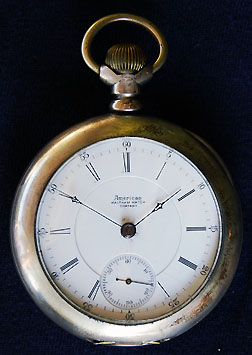 Use of original railroad standard pocket watches by museum docents and others in railroad operations can be an important part of interpreting railroad history. The first consideration, however, is the safety and preservation of original artifacts. Reliable time keeping is equally important. An antique railroad or other jeweled watch is delicate and requires care and regular maintenance to avoid damage, ensure reliable timekeeping, and to preserve it for the future. Here are a few guidelines:
Use of original railroad standard pocket watches by museum docents and others in railroad operations can be an important part of interpreting railroad history. The first consideration, however, is the safety and preservation of original artifacts. Reliable time keeping is equally important. An antique railroad or other jeweled watch is delicate and requires care and regular maintenance to avoid damage, ensure reliable timekeeping, and to preserve it for the future. Here are a few guidelines:
- An antique watch needs to be professionally serviced periodically by a watchmaker experienced with repairing antique watches that you can trust. Servicing involves disassembling, cleaning and oiling the watch. Over time the oils inside an antique watch will dry up, continuing use past the recommended time can cause excessive wear and cause the watch to become unreliable. Your watchmaker can tell you how often your specific watch should be serviced, they may recommend inspection more frequently.
- Wind your watch at the same time each day, preferably in the morning to provide full spring power during your most active hours. Wind gently until it feels a few clicks short of tight, don't overwind it.
- Almost all railroad watches made after 1900 are lever-set, to set the watch open or unscrew the front cover and gently pull the lever out, turn the pendant in either direction to turn the hands toward the correct time. Pendant set watches are set by pulling out the pendant to turn the hands to the correct time. Compare your watch to the designated standard clock to ensure that it is accurate within 30 seconds before starting railroad or museum work each day.
- When wearing a pocket watch it is best to use a chain to prevent it from accidently falling out of your pocket. Antique watches are very easily damaged by physical shocks, if it gets accidently dropped stop using and winding it until an experienced watchmaker checks it, even if it still seems to be running, to avoid additional damage.
- It is best to carry a pocket watch in a pocket separately from keys, change and other objects which can scratch or break the crystal or scratch the case.
- Avoid moisture, antique watches are not water resistant, and are subject to damage from moisture.
- Avoid extreme heat or cold. Freezing cold is not good for your antique watch, but it will stay protected in your pocket.
- Keep your watch in a dry spot when it is not in use, a watch display or holder which holds the watch stem up is recommended.
- Fingerprints should be removed with a non-abrasive jewelers polish cloth before your watch is put away or stored.
When selecting an original watch for museum railroad service it is best to keep in mind that as railroad technology changed, railroad watch technology did too, and railroad standard watch requirements followed the changing technology. As diesels began to replace steam locomotives during the mid-1930's, the watch manufactures introduced upgraded model watches to include non-magnetic balance parts to ensure reliability with diesel locomotives. By the mid-1940's only watches made after the mid-1930's were allowed to be used in service on some railroads. See Approved Railroad Watches for lists of approved watches during different time periods for several western railroads.
Watch Care Articles from the 1920's and 1930's
Proper watch care and maintenance was very important when pocket watches were in service on the railroads, peoples lives depended on it. Following are two articles on watch care, both from the Hamilton Watch Company, which apply to railroad and other jeweled mechanical watches from all manufactures.
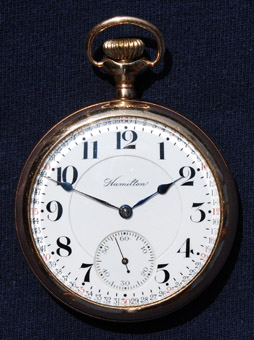 How You Should Treat your Hamilton Watch
How You Should Treat your Hamilton Watch
The Timekeeper: Hamilton Watch, the Watch of Railroad Accuracy, Hamilton Watch Company, Lancaster, Pennsylvania - 1924
The best way to carry your Hamilton is on a "T" chain, with the watch resting in your vest pocket. But whatever style of chain or fob you wear, the main point to consider is to keep the watch in a secure pocket, where it will not be knocked every time you move.
See that your watch pocket is free from dirt and lint - and keep it so. Avoid opening the back of the case. If you must open it let it be in a place where there is no dirt or moisture.
If anything is the matter with your timekeeper, don't try to put it in order - take it straight to your jeweler. All jewelers know the Hamilton, and if one of the tiny parts is broken he can replace it with a genuine replica of it. All Hamilton parts are standardized, so insist on having repairs made with genuine Hamilton material.
It is better, too, to let a jeweler set and regulate your watch. He charges nothing for this service and is glad to render it.
You can get the best results by winding your watch at the same time every day, preferably in the morning. By doing so you better prepare your watch for the jolts of daytime use.
Your watch is better off in your pocket at night than under a pillow. In fact, if it holds the same position it had in the daytime, the pocket is the best place for it. Your watch will then be in the '12 up' position, and in a far safer place than under a pillow, where is always in danger of being dropped to the floor.
Ask your jeweler to look at your Hamilton about every eighteen months (wrist watches about once every nine months) as it should be cleaned and oiled at least once in that time. If possible go to the jeweler who sold you your Hamilton for he is always interested in its performance.
The jeweler who sells Hamilton expects to give with it Hamilton service.
He will gladly adjust the watch to your personal habits and see that it keeps time for you in a satisfactory manner.
The guarantee made by the Hamilton Watch Company is also made by the jeweler from whom you purchase, and this the broadest possible one that be made. It is nothing less than complete satisfaction to you.
The Care of Your Watch
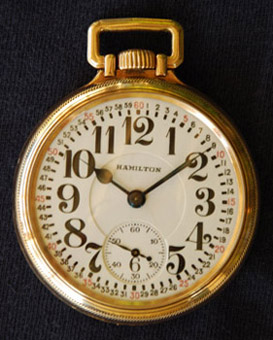 Hamilton Watch Company, Lancaster, Pennsylvania - 1931
Hamilton Watch Company, Lancaster, Pennsylvania - 1931
This is a plea for you to take good care of your watch – As Kipling has it, in speaking of the rifle --- “She’s human as you are. You treat her as such.”
It has been calculated that a locomotive would make almost twenty-eight complete circuits of the earth if it were started running on the equator and run until its wheels had performed the same number of revolutions that the balance wheel of a watch makes in a year. Can you imagine a locomotive doing this continuous running without frequent examination, cleaning, and oiling?
The best place to carry your pocket watch is in your vest pocket with the crystal toward your body. Various types of chains may be used, but whatever type of chain or fob you prefer to wear, the main point to consider is that the watch itself is carried in the pocket where the watch will not be knocked every time you move.
Keep your watch pocket free from dust and lint. By doing so you eliminate the possibility of dust and lint working their way through the watch case into the movement. The wrist watch, as the name implies, belongs on the wrist and performs best when worn at all times, except when one is bathing or washing. The heat of the body and the personal habits of the wearer help maintain a constant rate of time telling.
Avoid opening the back of a watch case. If it must be done, do it in a place where foreign particles and moisture cannot settle on the mechanism. Wind your watch every twenty-four hours. While it is true that Hamilton watches will run more than twenty-four hours at a winding, it is best to wind any watch once every day, preferably at the same time in the morning, in order to give your watch full spring power during your most active hours. In setting your watch, simply turn the hands in the nearest direction toward the correct time. There is no danger of injury to the movement in rotating the hands either forward or backward.
At night your pocket watch is best kept in your vest pocket. Do not place it under your pillow or in other places where it is liable to be jarred to the floor or subjected to varying degrees of temperature. 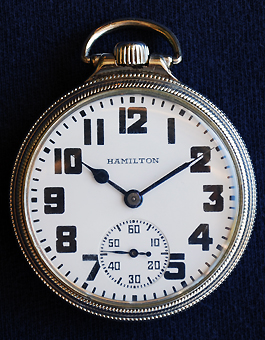 If it is inconvenient to keep it in your vest pocket, place it in a position where it is not liable to fall and where it will not be near open windows or hot radiators.
If it is inconvenient to keep it in your vest pocket, place it in a position where it is not liable to fall and where it will not be near open windows or hot radiators.
For most constant time telling service, a strap watch should be worn by its owner to bed as well as during waking hours.
A pocket watch should be cleaned and oiled once every twelve to eighteen months and a wrist watch from every six to ten months. For this purpose take it to a jeweler in whom you have confidence and who is an expert watchmaker or who employs one. The proper cleaning of a watch is not a perfunctory job to be done in a few days. A watchmaker will take the watch movement apart. He will then wash in benzene all the jewel mountings, jewels, screws, wheels, balance, etc., to remove accumulated dirt and old oil. After this operation, the parts are thoroughly washed in a special soap solution, cleaned in cyanide, again with soap and water and finally immersed in alcohol and properly dried. Each of the parts is then separately polished and reassembled. All bearing surfaces are carefully oiled with the best grade of watch oil. A skilled watchmaker, in fact, does exactly what the skilled watchmakers of the Hamilton factory do when they “finish” a watch for delivery. It may be that your watch at the time of cleaning has accumulated very little outside dirt, but the oil may have gummed to a certain extent. This, if not removed, will have a tendency to slow up action and so cause variations in time. It will also cause wear on the delicate pivots which rest in the jewels.
The following table can be followed in having your watch examined, cleaned, and oiled:
- 16 size railroad watches or watches of larger size – every 12-15 months
- 12 size thin models – every 12 months
- Men’s wrist watches – every 10 months
- Ladies’ wrist watches – every 6-8 months
Have you ever noticed how the bearings of a motor car run in bronze bushings? It is a well known mechanical law that to gear the same metals together or to permit similar metals to wear on each other is to court disaster. Metal-to-metal wear is reduced when the metals are of different character. Thus, you will find the gold or brass wheels run into steel pinions and that in high-grade watches jewels are used as bearings for the pivots, escapement, balance, and other parts. It is a quite common impression that jewels are placed in a watch movement for the purpose of ornament. As a matter of fact, they are placed there for the very important purpose of wear-proof bearings. They have a fundamental and practical value in a watch. They are, in fact, so important that they are a gauge of a watch’s quality. So it is that watches of 17 jewels or more are considered high-grade watches. All Hamilton watches have 17 or more jewels.
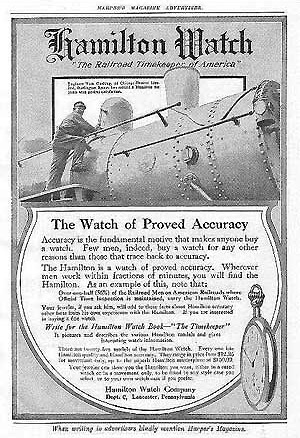 Every watch, to obtain the maximum of accurate timekeeping, should be regulated to the personal activity of the owner. A watch will not take the same rate -- that is, render identically the same time service – when carried by two people, even though these two people may have almost identical habits.
Every watch, to obtain the maximum of accurate timekeeping, should be regulated to the personal activity of the owner. A watch will not take the same rate -- that is, render identically the same time service – when carried by two people, even though these two people may have almost identical habits.
While it is quite common to check the performance of a new watch immediately after one begins to carry it, it should be carried several weeks before such checking is made. Then careful attention should be given to its rating before the regulator is touched. A competent watchmaker should then regulate the watch. A Hamilton thin model will show a difference of approximately 20 seconds in 24 hours when the regulator screw is given a full turn. In Hamilton railroad models, this variation will run up to as much as 1 second per hour. Never attempt to regulate your watch yourself. Your jeweler will always be glad to render this service at any time.
Magnetism is an enemy with which every watchmaker and watch owner must contend. A magnetized watch will not keep time accurately. Therefore, care should be taken not to wear a watch of good grade within the influence of a powerful magnetic field. By magnetism, we do not mean the ordinary electric circuits in homes, offices or factories. This is really insulated electricity. Magnetism, while a form of electricity, is not active in that sense but a phenomenon that is caused by an electric current. Watches can be de-magnetized by a special instrument built for the purpose. To test a watch for magnetism, place a small compass over the balance wheel. If the movement is magnetized the compass will vibrate with the balance wheel. If the watch is not magnetized, the needle of the compass will point magnetic north. Do not bring your watch any closer than necessary to receivers of radio sets or telephones nor walk close to unshielded dynamos of transformers. Keeping these things in mind will insure you a freedom from annoyance that a magnetized watch causes.
Perfect timekeeping is something that man will never attain by an instrument of his own making. The only truly accurate time can be taken from the stars. Even the earth has been known to be a trifle behind time, and so has the moon. These variations, however, have not been set by timekeeping instruments but by the stars themselves as observed by man.
The precision clocks in the Unites States Naval Observatory and the Master Clock at the Hamilton Watch Company come as close to perfection in timekeeping as any instrument built today (1931). These clocks are placed on concrete pedestals whose bases are in no way connected to the building which houses the instruments. The bases are placed on separate foundations sunk deeply into the ground and thus guarded against vibrations taking place in the building itself which would cause time variations. The clocks are sealed in air-tight chambers and all operate in a temperature that is constant and unvarying. The sway of the pendulum is regulated by the friction of the remaining air. The air of the chambers is either pumped out or added to, and in this manner the clocks are adjusted. The air friction on the pendulum is the adjusting factor. With all these safeguards the clocks will not record time perfectly, but can be adjusted to within 1/100 of a second of accurate time a day.
The requirements of railroads, where time inspection is maintained, demand that a watch run within 30 seconds variation a week. It is significant that the Hamilton Watch is the favorite of most railroad men, meeting time inspection requirements, and with proper care, performing dependably year after year.
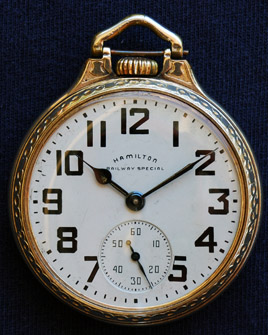 Watches of high grade – 17 jewels or better – are usually adjusted for temperature variations. That is, they are adjusted to keep time at temperatures varying as much as 70 degrees. Additional adjustments are the position adjustments, which mean that the watch has been timed, tested and adjusted to operate within certain limits when the watch is in any or all of the following positions; “Twelve Up”, as the watch is while resting in your pocket; “Nine Up”; “Three Up”; “Dial Up”; and “Dial Down.”
Watches of high grade – 17 jewels or better – are usually adjusted for temperature variations. That is, they are adjusted to keep time at temperatures varying as much as 70 degrees. Additional adjustments are the position adjustments, which mean that the watch has been timed, tested and adjusted to operate within certain limits when the watch is in any or all of the following positions; “Twelve Up”, as the watch is while resting in your pocket; “Nine Up”; “Three Up”; “Dial Up”; and “Dial Down.”
Another adjustment has to do with the hairspring and balance so that these parts insure an absence of variation between the time of winding and rewinding a watch.
A good wrist watch for men or women is an even more delicate piece of mechanism than the thin pocket watch. These wrist watches, of course, cannot be expected to render the same time service as that rendered by the high-grade pocket models, due to their smaller size and the more vigorous treatment they receive when worn on the wrist. Hamilton wrist watches, however, have become famous for their surprising accuracy.
The primary purpose of a watch is to keep accurate time, and the Hamilton Watch Company builds its watches with this purpose uppermost in mind.
For additional information:
As with automobiles and other machinery, use of modern lubricants and cleaner working conditions may reduce the required frequency of cleaning and lubricating antique jeweled watches and clocks, but it doesn't eliminate the need for ongoing inspection and maintenance. Dirt, rust, old oil or insufficient lubrication may result in less reliable time keeping, increased wear on watch parts and serious damage to the watch. Replacements for worn or damaged antique watch parts may not be readily available. It is recommended antique watch owners contact a local watchmaker who is experienced with antique watches for regular inspection and guidelines in maintaining their specific watch.
American Waltham Aurora Ball Columbus Elgin National Hamilton Hampden E.Howard Illinois Peoria Rockford South Bend Seth Thomas U.S.Marion U.S.Waltham
Sharing A Heritage Railroad History Train Technology Railroad Operation Railroad Time Museums & Heritage Railroads Railroads Today
